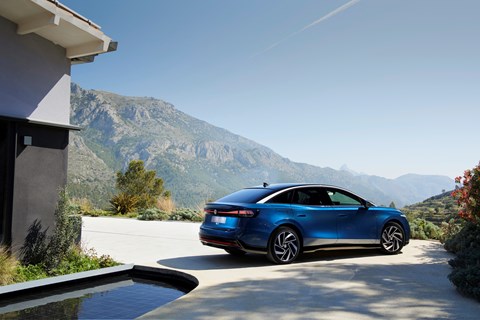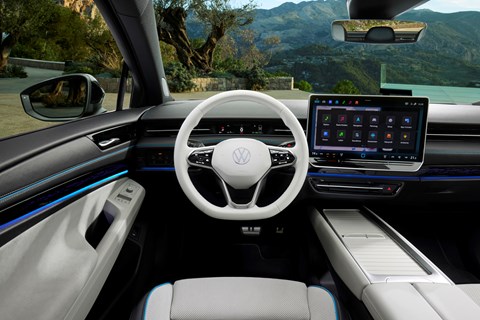► Volkswagen ID.7 electric flagship to start from £55,570
► 384-mile range from launch edition, long-range model coming later
► Estate model will also join the range
Volkswagen has announced that the its new flagship, the ID.7 electric car, will cost from £55,570. The electric saloon is available to order now, with ‘a number of highly attractive offers’ available until January 2, 2023.
Buyers of the ID.7 Pro Launch Edition can enjoy a free home wall charger or £750 in public charging credits, as well as a £3000 deposit contribution and a reasonable 4.9% APR PCP deal.
Pricing for other trim levels, or the ID.7 Tourer estate, has yet to be revealed. However the Pro Launch Edition comes well-equipped with 19-inch alloys, LED lights all round, the new 15-inch ‘Ready 2 Discover’ infotainment system, heated front seats, three-zone climate control and the usual assortment of safety kit.
That price puts Volkswagen in a competitive area of the market. It’s priced identically to an entry-level BMW i4 and more expensive than a (admittedly smaller) Tesla Model 3 Long Range or Polestar 2 Long Range. However, it does undercut similarly-sized premium competition such as the Mercedes-Benz EQE.
Volkswagen ID.7 Tourer confirmed
Passat buyers rejoice! Volkswagen has confirmed an estate version of the ID.7 will hit its showrooms in 2024. It’ll be called the ID.7 Tourer and it’ll team the standard car’s swoopy styling and efficient 400-mile-plus-capable electric powertrain with a boot large enough to hold the entire contents of your local garden centre.
It’ll become Volkswagen’s first-ever electric estate car. When it goes on sale, it’ll compete against a mere handful of diverse rivals that include the MG 5 EV, Porsche Taycan Cross Turismo and Vauxhall Astra Electric Estate.
Volkswagen says that, with the rear seats folded flat, the ID.7 Tourer can carry up to 1714 litres of luggage. That figure is 82 litres larger than the company’s previous posh estate, the Arteon Shooting Brake. And with the rear bench in place, you still have 545 litres of space in the boot which should be ample for a week’s luggage.

Don’t scoff – Volkswagen reckons the ID.7 Tourer will be able to live up to its namesake and become an electric car you can comfortably drive over long distances. The company hasn’t yet confirmed the EV’s official range, but we’re expecting the impact of the new estate body to be minimal. Volkswagen says the change has only dropped the car’s drag co-efficient from 0.23 to 0.24.
We’ve already spotted an undisguised ID.7 Tourer prototype undergoing testing, but the car in Volkswagen’s official images wears a light camouflage wrap. The front end of the car remains unchanged – and buyers will be offered the same range of powertrains, battery packs, optional extras and interior technology as the saloon. You can read more about these specifications below.
Volkswagen ID.7: what you need to know
The Volkswagen ID.7 is the new flagship of the brand’s ever-growing electric ID range, and one of ten electric cars Volkswagen intends to launch by 2026. It’s an Arteon-sized saloon that was designed to target the upper mid-range segment – and it introduces some clever new powertrain technology along with some much-needed interior revisions over the Volkswagen existing ID cars.
It’ll be launched worldwide (unlike some ID models), with the saloon version of the car hitting European and Chinese markets by the end of 2023 before making the leap across the Atlantic to North America in 2024. The ID.7 will be manufactured in Volkswagen’s plant in Emden, Germany alongside the ID.4 SUV.

Before Volkswagen officially acknowledged the existence of the ID.7 Tourer, the biggest news was the car was to become the third ID model to feature a hot GTX variant. It’ll get an undisclosed uptick in power plus a load of sporty styling tweaks to hopefully make up for the lack of a shouty turbocharged four-cylinder petrol engine. More on that below.
Same face, new body style
Look at the ID.7 from the front, and you’d be forgiven for mistaking it for an ID.3. Volkswagen has decided on a look for its ID range and it isn’t straying an inch from it. Just like the ID.3 hatchback, it features short overhangs, a stubby bonnet, flush headlights and a raked windscreen. This styling isn’t just for show, either. It helps the ID.7 achieve a super sleek 0.23 drag co-efficient.
After driving a near-production prototype, we must report that this comes with a compromise, though. Like the ID.3, this super-raked look does have an impact on visibility. Shame. But these are the sacrifices we make in the name of progress.

Move away from the front and the ID.7 grows into a 4961mm saloon, with a low 1862mm roof. There isn’t much design happening down the car’s flanks, but it gets more interesting the further back you go. The rear lights, for example, have something of the Peugeot 408 about them. All things considered, though, this isn’t a particularly memorable-looking car. It’s the considered, understated design approach we’ve come to expect of the ID range, stretched to be saloon sized.
What are the tech specs?
The ID.7 debuts a raft of new technology seen for the first time in any ID car. Powertrain-wise, the electric saloon comes with a new 210kW motor that features stronger magnets, more windings, a higher wire cross-section and improved cooling. The overall result is a bump in efficiency and power, and one we expect to see trickling down to the rest of the ID range in time.
From launch, buyers will only be offered the ID.7 Pro. It’ll be fitted with a 77kWh (gross 82kWh) battery pack that Volkswagen says is good for an estimated range of 382 miles (615km). A longer-legged Pro S model will arrive later featuring VW’s biggest battery to date – an 86kWh unit (91kWh gross) offering a maximum range of 434 miles (700km).

The ID.7 will also become the first in its family to feature battery charge preconditioning. Simply prod the location of a charging station into the sat-nav and the car will prepare its battery to receive the maximum 200kW charge rate by the time you get there. Interestingly, this can be triggered manually too – great for those using Apple CarPlay or Android Auto.
What are the tech specs?
The ID.7 debuts a raft of new technology seen for the first time in any ID car. Powertrain-wise, the electric saloon comes with a new 210kW motor that features stronger magnets, more windings, a higher wire cross-section and improved cooling. The overall result is a bump in efficiency and power, and one we expect to see trickling down to the rest of the ID range in time.
From launch, buyers will only be offered the ID.7 Pro. It’ll be fitted with a 77kWh (gross 82kWh) battery pack that Volkswagen says is good for an estimated range of 382 miles (615km). A longer-legged Pro S model will arrive later featuring VW’s biggest battery to date – an 86kWh unit (91kWh gross) offering a maximum range of 434 miles (700km).

The ID.7 will also become the first in its family to feature battery charge preconditioning. Simply prod the location of a charging station into the sat-nav and the car will prepare its battery to receive the maximum 200kW charge rate by the time you get there. Interestingly, this can be triggered manually too – great for those using Apple CarPlay or Android Auto.
And the interior?
Volkswagen’s most recent infotainment system is the Achille’s heel of everything from the Golf to the Cupra Born – and the ID.7 represents Wolfsburg’s first attempt to fix some of its mistakes. So, the volume bar is now backlit, which means you can see where to swipe at night. Plus, the climate controls now have their own permanent hot bar on the saloon’s bright 15-inch infotainment screen. The result? You can see where to swipe now, and doing something as simple as changing the cabin temperature doesn’t take four screens of swiping and poking.
Volkswagen’s engineers were also keen to point out the amount of customisation the new infotainment screen will offer. There are ‘favourite bars’ for your most-used apps, it’s possible to create your own ‘tiled’ home screens and you can customise a ‘car control centre.’ There’s also a range of shortcuts which owners will almost certainly learn and use to speed things up even more.

Elsewhere, the ID.7 drops the pod-style cockpit dials of the ID.3 and ID.4 in favour of a smaller unit that’s integrated into the line of the car’s new ‘Smart Air Vents’ (more on those later). Volkswagen points to a new customisable augmented reality-enabled HUD as the primary display for the driver, with the amount of information it shows varying between a full view and a pared back one.
It’s not all good news though. VW’s Smart Air Vents can be saved to user presents or be used in conjunction with the car’s voice controls – but alarmingly, they can only be moved by using the touchscreen. The result? If you want to change the direction of the vents you’ll need to delve into a dedicated screen and drag each one, or call out a setting to the car’s voice assistant.

Sure, they may make the cabin look slightly neater, but ultimately these vents are another solution to a problem that doesn’t exist. What’re the chances of them being replaced by standard vents on the second-generation ID.7?
The ID.7’s other party pieces include a panoramic sunroof with electrochromic technology, as well as a massage seats and ambient lighting. A 14-speaker, 700-watt sound system is also available.
GTX version on the way
This isn’t a huge surprise. The ID.7 follows on from the ID.4 and ID.5, both of which are available with Volkswagen’s sporty GTX specification. However, while Volkswagen has acknowledged the ID.7 GTX’s existence, it hasn’t yet confirmed how much extra performance it’ll get over the standard car.
If the other GTX models are setting the precedent, don’t expect huge gains in performance. Rather than being akin to its GTI models, the GTX trim is closer in character to Volkswagen’s GTE and GTD cars. We’re expecting a slight power increase, but nothing ground breaking.

Volkswagen’s GTX trim is as much about the styling as it is the performance – and the ID.7 will be no exception. It’ll feature a red and black colour scheme inside and out, with the dark crimson being completed by gloss black replacements for the car’s door mirrors and roof. Inside, you’ll get contrasting stitching on the seats, dashboard and door panels.
The GTX made its first global appearance at the IAA Mobility show in Munich on the 5 September 2023.
Anything else?
The ID.7 comes with assisted parking and features assisted lane changing and adaptive lane guidance. You can read our early impressions of a near production prototype here.